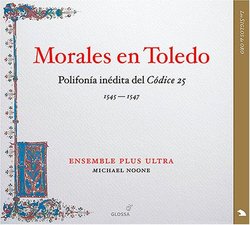| All Artists: Cristobal de Morales Title: Morales en Toledo: Polifonía inédita del Códices 25, 1545-1547 Members Wishing: 0 Total Copies: 0 Label: Glossa Release Date: 4/26/2005 Album Type: Import Genre: Classical Styles: Opera & Classical Vocal, Historical Periods, Early Music Number of Discs: 1 SwapaCD Credits: 1 UPCs: 675754827724, 8424562220010 |
Search - Cristobal de Morales :: Morales en Toledo: Polifonía inédita del Códices 25, 1545-1547
 | Cristobal de Morales Morales en Toledo: Polifonía inédita del Códices 25, 1545-1547 Genre: Classical
|
Larger Image |
CD Details |
CD ReviewsSensational discovery, sensational CD Kenneth Kreitner | Memphis | 06/27/2005 (5 out of 5 stars) "If you have heard of Michael Noone and the Ensemble Plus Ultra, you probably already know something about this project and will rejoice in the arrival of the CD. If not, a quick version of the story is in order.
It's an amazing project: for decades the musicological world has been tantalized by the manuscript Toledo 25, copied in the 1540s at the Toledo cathedral -- a large and luxurious source, presumably full of great stuff but inaccessible, having suffered severe water damage at some point and gotten its pages hopelessly stuck together. Michael Noone somehow got permission to take a look at the thing, and he managed to get the pages apart, to transcribe what was there in this horrible mess, to reconstruct what had been damaged irreparably, and to publish an edition-including some 21 new compositions by Cristóbal de Morales. It was one of the sensations of recent renaissance musicology; now, equally sensational, Noone and his ensemble have taken the next step and released a CD of this newly-discovered music (along with a few other Morales pieces in other Toledo manuscripts). And it's terrific. This is not the sort of renaissance music that gets recorded a lot on conventional CDs: it's mostly straightforward liturgical stuff for the regular service-hymns, canticles, psalms, etc.-and most of it is written for performance in alternatim with chant, which tends to put it at arm's length for some modern listeners. But don't anyone be intimidated: the chant is tastily sung, it moves along quickly, and it serves as a dramatic plain frame for Morales's polyphonic settings, which always incorporate the chant somewhere in the web. And the singing is just spectacular. Noone and his people seem to have a feel for the mid-sixteenth century like no one else I have ever heard. This is an oddly difficult repertory to pull off: its dense polyphonic texture doesn't guide singers along, the way Josquin's music does on the one side and Palestrina's on the other, and the long, long imitative lines are not easy to shape coherently. But check out especially the first cut (Asperges me) and the last (an extravagant setting of the hymn Ave maris stella) and see how ravishing these people make it. In short, feel free to buy this CD for the musicology; I promise you'll end up listening to it for the music and the musicianship." |

 Track Listings (14) - Disc #1
Track Listings (14) - Disc #1